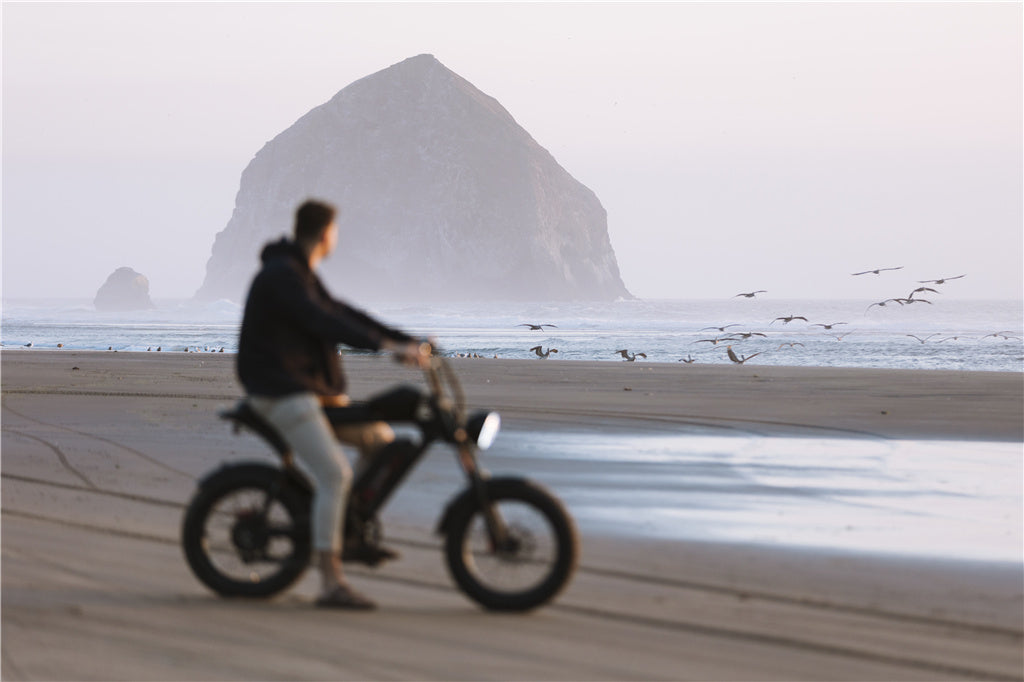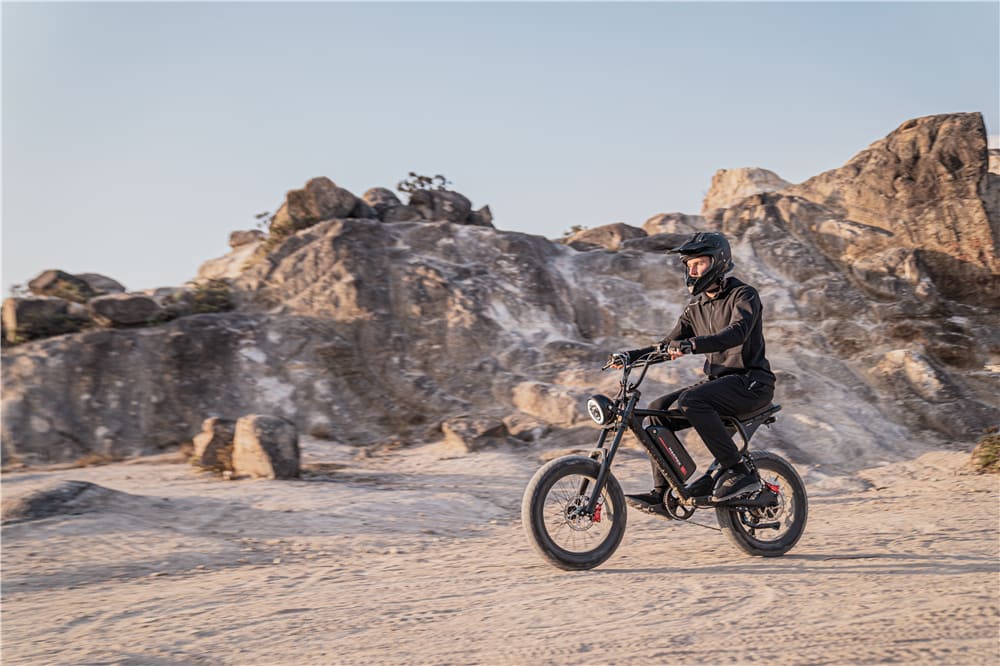Fat tire bikes have grown increasingly popular due to their unique appearance and adaptability across various terrain.
No matter your experience level or cycling preference, understanding the pros and cons of specific bikes can elevate your cycling experience.
This article presents both sides of fat tire bikes to help you decide if they suit your cycling needs.
What are Fat Tire Bikes?

A fat tire bike can be identified by its large, wide tires - typically measuring at least 3.8 inches wide - mounted onto wider rims for improved balance and performance on uneven terrain.
Bikes designed specifically for use on snow and sand have become versatile options suitable for all riders seeking comfort and reliability in their cycling endeavors.
Fat tire bikes first made their debut in Alaska in the late 1980s as a means of traversing its snowy landscapes. Since then, their use and popularity have spread worldwide, opening doors to unique cycling experiences for riders worldwide.
Traditional bicycle tires tend to be much narrower, typically between 1 inch and 2.5 inches wide, and designed specifically for various forms of riding.
Road bikes feature thinner, smoother tires designed to increase speed and efficiency on paved surfaces.
Mountain bikes feature wider tires with more aggressive tread patterns, which make them easily adaptable to uneven terrain and navigate uneven roads.
Traditional tires allow for faster movement but may compromise stability and comfort on non-traditional surfaces like gravel or snow, where fat tires excel.
Fat tire bikes represent an exciting departure from traditional bicycle designs. They prioritize greater ground contact area to disperse rider weight more evenly across their surface area.
Fat tire bikes feature an innovative design that ensures stability and grip across different terrains, making them a popular choice among cyclists who want to explore further than they ever thought possible.
What is a Fat Bike Good For?
Fat bikes are designed to adapt quickly and remain resilient in any setting, providing versatile transportation in demanding and recreational contexts. Here are a few specific uses where fat bikes excel:
-
Off-Road Trail Riding: Fat bikes excel on off-road trails where loose, soft, or slippery surfaces such as sand, mud, and snow may be prevalent. Their wide tires offer necessary traction and stability in such terrains, making fat bikes ideal for mountain biking adventures in various weather conditions.
-
Winter and Snow Biking: Fat tire bikes were originally developed as snow bikes, providing riders with an efficient means of exploring wintry landscapes without needing special ski equipment—an unforgettable biking experience during colder months.
-
Adventure and Expedition Cycling: Fat bikes offer adventure cyclists the ability to go where other bikes simply cannot, from desert crossings to arctic expeditions. Their robust construction helps meet the challenges associated with extreme adventure cycling by providing reliable performance when needed most.
-
Beach and Coastal Riding: Fat bikes' unique capabilities make them well-suited for beach environments. They provide easy navigation through sandy areas while remaining light enough for riding along the shoreline.
-
Recreational and Family Outings: Fat bikes offer recreational riders an easy, enjoyable, and forgiving riding experience that's popular for leisure activities in parks, rural trails, and scenic paths. Their gentle ride provides smooth sailing experiences for cyclists of all ages and experience levels.
-
Commuting in Varying Conditions: Fat bikes provide an efficient and flexible means of travel in cities with diverse terrain and weather, providing safe travel on streets that may be wet, icy, uneven, or otherwise challenging - increasing daily commute safety while making life more pleasant!
Macfox X2
$1,699.00 – $2,198.00Pros of Fat Tire Bikes
Fat tire bikes provide many distinct advantages that make them popular among various cycling enthusiasts.
From improved stability to increased comfort, these bikes are made to overcome all kinds of challenging environments.
Here are a few key benefits:
Stability and Traction
One of the primary advantages of fat tire bikes is their outstanding stability and traction capabilities.
Large tires feature a large surface area that comes into contact with the ground, offering more stable rides on all terrain types.
These bikes can be beneficial on surfaces like snow, mud, and sand, which traditional bikes struggle with, such as slippery roads.
Increased traction allows riders to maintain better control when ascending or descending a climb or descent, improving safety and confidence on the trail.
Comfort and Forgiving Ride
Fat tire bikes feature wide tires that serve as natural shock absorbers, providing an enjoyable and relaxing riding experience.
Even without sophisticated suspension systems, the air volume in these tires allows them to compress over bumps and obstacles, improving their ride under challenging conditions.
Fat tire bikes are particularly advantageous for long and challenging trails, as their design reduces fatigue and discomfort caused by constant jarring.
Versatility
Fat tire bikes are an incredibly flexible option, capable of excelling across various conditions and terrains.
Winter biking enthusiasts prefer them for their ability to handle snow and ice terrain, while beachgoers and adventurers who need one bike for all conditions find them invaluable.
This adaptability also extends to recreational applications, like family trips on mixed-surface paths where a more comfortable ride would be greatly appreciated.
Year-Round Utility
Fat tire bikes provide year-round Utility, unlike many specialized bikes that may only work during certain seasons or conditions.
Their design allows them to excel in winter conditions, eliminating the need to store them away during colder months.
Their resilient nature makes them suitable for riding in wet and muddy conditions - prolonging the cycling season without compromise!
Related Reading: 4 Things You Want to Know About Fat Tire E-bikes
Cons of Fat Tire Bikes
Fat Tire Bikes While fat tire bikes are known for their ability to adapt and conquer various terrains, potential drawbacks may influence a buyer's decision.
Below are the primary drawbacks associated with buying a fat tire bike:
Weight
A significant drawback of fat tire bikes is their weight.
Due to their sturdy frames and larger tires, hybrid bikes tend to be heavier than traditional mountain or road bikes and may prove more challenging to manage and transport.
Weight can deter some cyclists, especially those navigating obstacles or stairs on their ride; long climbs become even more strenuous with additional weight on board.
Speed and Efficiency
Due to their large, heavy tires, fat bikes are typically slower than their conventional counterparts.
As rolling resistance increases, more energy must be expended to keep up with speeds on paved roads, particularly where there is minimal rolling resistance.
Fat bikes may lead to faster fatigue than expected, making them less suitable for riders interested in speed or covering long distances efficiently.
Maintenance
Fat bike tires and rims often require additional attention during their upkeep.
As with standard bikes, hybrid bikes can suffer punctures and wear, though repairs can often be more expensive due to specialized components.
Furthermore, tires may gather more dirt due to their larger surface areas, necessitating frequent cleaning for optimal performance.
Read more: How to Fix Ebike Tires: Tubed vs. Tubeless—Quick Guide
Cost
Fat tire bikes tend to be more costly than other forms of bicycles.
Costly investment items for any customized build, like more extensive tires, specialized rims, and frames, include more extensive tires, specialty rims, and frames that accommodate your build.
Casual riders or those just beginning cycling may find the price point prohibitive compared to more conventional options.
Macfox X1
$999.00 – $1,497.00Expert Opinions on Fat Tire Bikes
We enlisted input from various industry professionals to provide a more thorough picture of what it means to own and ride a fat tire bike.
These opinions shed light on the positive attributes and challenges associated with fat tire bikes.
Benefits Highlighted by Experts
Many cycling experts praise fat tire bikes for their revolutionary design that opens up cycling to seasons and terrains previously off-limits.
"Fat bikes allow cyclists to explore new frontiers of cycling - from winter snow packs to sandy dunes," notes Dr. Helena Richards, an outdoor sports equipment sports scientist.
Experts unanimously acknowledge the unique abilities of fat tire bikes as an essential factor in expanding access to and enjoyment of cycling sports.
Challenges Noted by Experts
However, experts note the risks involved.
"While fat tire bikes may appeal to buyers, prospective purchasers should be mindful of the increased physical effort required to use and ride one on traditional roads," advises Tom Bennett, an experienced bike mechanic with 15+ years in bicycle maintenance.
Cost considerations are frequently discussed when discussing electric bikes; many note that their initial investment and ongoing maintenance can be significantly more than those of traditional bikes.
Balancing Views
Experts generally agree that purchasing a fat tire bike should depend on each rider's intended use and environment.
As cyclist and author Emily Carson puts it, fat tire bikes may be perfect if your primary concern is year-round comfort or urban commutes. Still, "if speed or urban commuting is your focus, other more suitable options may be available."
Are Fat Bikes Suited for Street Riding?

Fat bikes, well-known for their durable tires and off-road capabilities, may be suitable for urban streets - with certain restrictions.
Although these bikes excel in rough terrain such as sand, snow, and mud, their wide tires allow for superior traction and stability off-road but increase rolling resistance on paved roads.
Fat bikes may be less effective for daily commuting or fast urban cycling than road or hybrid bicycles.
On the upside, fat bikes offer an exceptionally comfortable riding experience on city streets filled with potholes, cracks, and other irregularities.
These thick, cushiony tires absorb shocks remarkably well, providing comfort during long rides through urban environments.
As such, they make them an appealing option for leisurely city rides or cyclists prioritizing comfort over speed.
However, its practicality for regular street riding depends on a rider's needs and local terrain.
Fat bikes provide superior grip and control in cities where streets frequently become wet or icy, making them an appealing option despite their bulkiness and slower speed.
Urban environments that feature gentler terrain may outweigh any benefits in terms of speed and agility.
Conclusion
Fat tire bikes provide unique advantages and disadvantages for various cycling needs.
They offer stability, comfort, and year-round Utility - perfect for exploring various terrains and conditions.
However, weight, speed limitations, maintenance needs, and cost must also be considered.
Ultimately, purchasing a fat tire bike should reflect your personal riding goals and the adventures you intend to have.
Call to Action
Are you curious to experience what a fat tire bike could bring to your riding experience? Visit a bike shop and test one out, or connect with online communities for user experiences—perhaps finding your perfect bike is just one ride away!
FAQs
Can fat tire bikes be used for daily commuting?
Fat tire bikes can be an efficient mode of transportation when riding through areas with varied terrain or rough road conditions; however, their heavier weight and broader tires could make them less effective on smooth paved roads.
Are fat tire bikes challenging to maintain?
Fat tire bikes require maintenance similar to standard bikes; however, their specialized tires and rims may cost more. Regular cleaning is necessary to prevent build-up from mud and debris build-up.
Are fat tire bikes suitable for riding on snow and sand?
Absolutely. Fat tire bikes excel on challenging surfaces like snow and sand due to their wide tires, which provide superior stability and traction than standard bicycles.




















